CAT Strategic Completes Initial Ground Follow-Up Exploration Over Geophysical Anomalies on South Preston Uranium Project
CAT Strategic Metals Corporation has reported promising results from its airborne mag-EM geophysical survey over the South Preston Uranium Project in the Athabasca Basin, Canada. High background radioactivity areas and NE-striking conductors were identified, suggesting potential uranium deposits. The company conducted follow-up biogeochemical sampling, yielding uranium values up to 187 ppm and indicating significant anomalies. WGM's analysis indicates high potential for uranium resources, with encouraging findings in both western and eastern survey areas. CAT's project encompasses 29,395 hectares and borders Azincourt Energy's promising G-Zone.
- Geophysical survey results indicate high background radioactivity and NE-trending conductors associated with potential uranium deposits.
- Biogeochemical sampling returned uranium values up to 187 ppm, with significant anomalies exceeding 28 times the mean values.
- Geophysical data suggests localized uranium sources along conductive corridors, enhancing exploration prospects.
- None.
Insights
Analyzing...
VANCOUVER, BC / ACCESSWIRE / February 9, 2023 / CAT Strategic Metals Corporation (CSE:CAT)(OTC:CATTF)( FRA:8CH) ("CAT" or the "Company") announces an update to the previously reported the completion of an airborne mag-EM geophysical survey in July, 2022 over portions of its South Preston Uranium Project in Canada's prolific Athabasca Basin. (The property outline is shown in Figure 1).
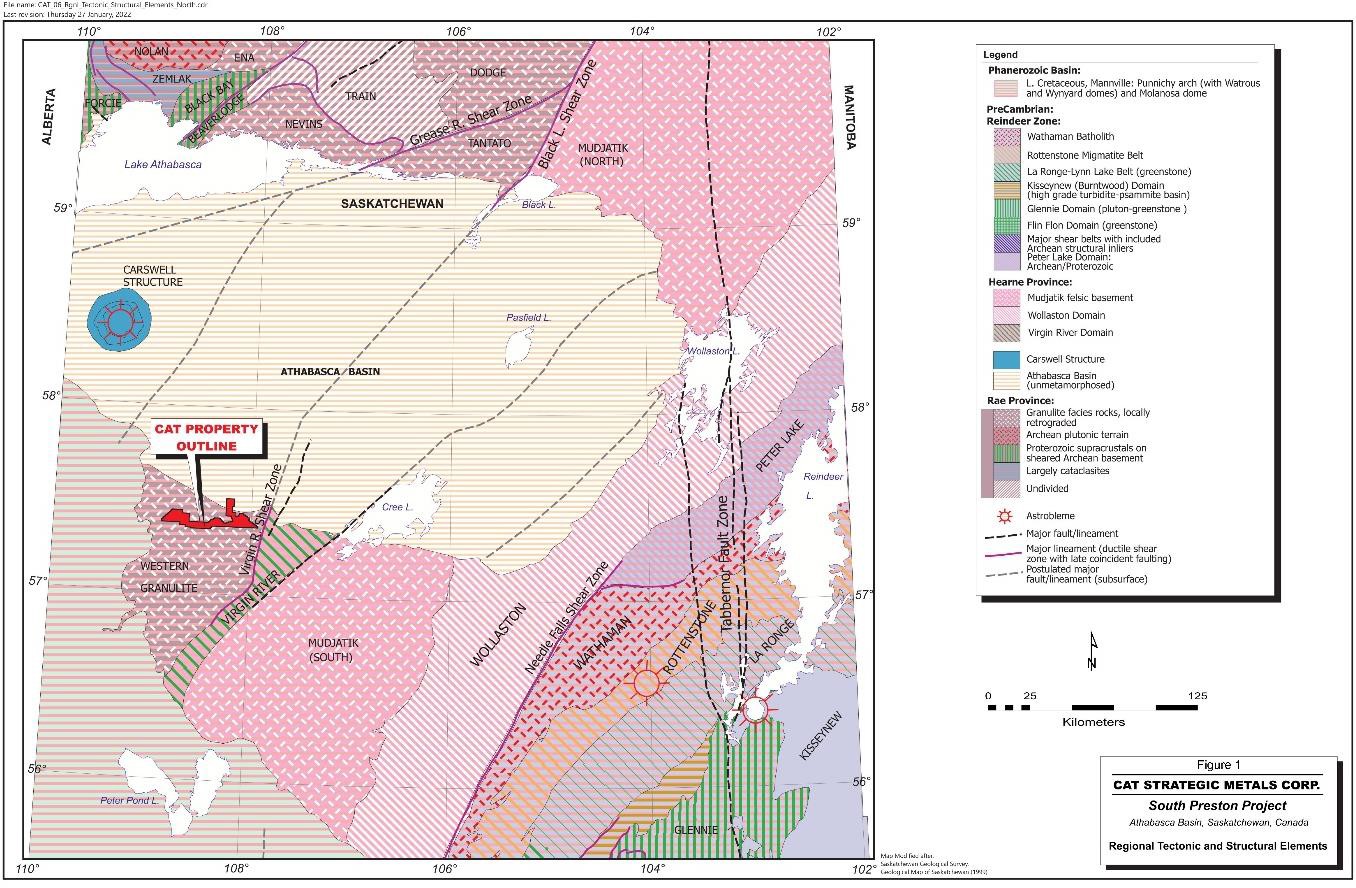
Although very little exploration has been carried out on the property, historical and recent exploration in the surrounding area have outlined features that are summarized in Figure 2. Airborne geophysical surveying identified areas of high background radioactivity in western areas of the property and NE-striking conductors were located to the north and trending towards the CAT property. On-going exploration by Azincourt Energy Corp. ("Azincour or AAZ") has identified conductive corridors which have recently been drilled and have been shown to contain sheared, graphitic basement rocks that are commonly the host for uranium deposits elsewhere in the Athabasca Basin.
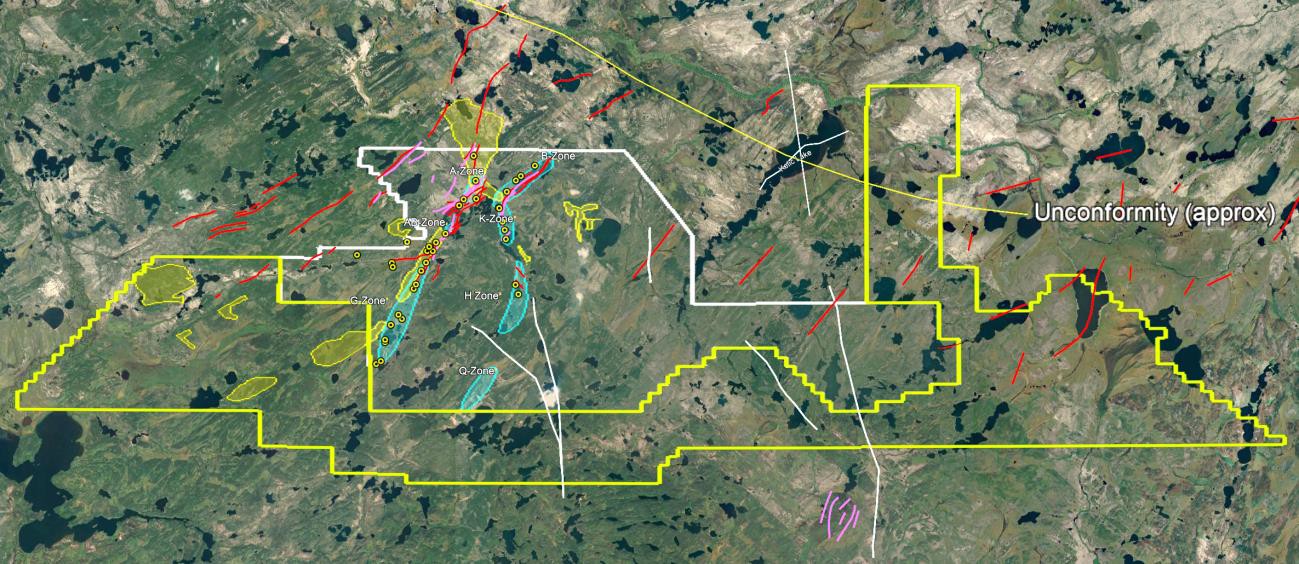
Figure 2: The CAT property is outlined in yellow. The light blue areas left of centre are conductive corridors currently being explored by Azincourt with its drill holes shown as yellow dots. The light blue band located right of centre is a zone of graphitic metasedimentary rocks. Areas of elevated radioactivity from historical surveys are shown as yellow-filled polygons outlined by white. Red lines shown the location of EM conductors identified previously in thegeneral area. White traces, generally trending N-S or NW-SE, are lineaments interpreted to represent major fault zones. The approximate location of the Athabasca unconformity is indicated by the yellow line arcing across the top of the image from centre towards the right (east). The area of view is approximately 60 kilometres west to east with Lloyd Lake located at lower left.
CAT's airborne EM and mag survey in the ‘Western Block' identified a series of NE-trending conductors, some of which are on-strike with the graphitic conductors currently being drilled by Azincourt on its adjacent property to the north (Figures 3 and 4). Another zone of interest surveyed as the ‘Eastern Block' is located in the general vicinity of surface uranium mineralization reported by Denison Mines in 1970. CAT's exploration is carried out under the management of Watts, Griffis and McOuat Ltd. ("WGM") which commented:
"The geophysical survey results are very encouraging. The exploration confirmed the location of a major conductive zone beneath a drainage system that follows a very strong NE-trending structural lineament. Similar lineaments are closely associated with uranium deposits in much of the Athabasca Basin, and WGM's view of the uranium potential of the CAT project is very high."
On September 22nd, 2022, CAT announced the completion of bio-geochemical exploration and geological prospecting over conductive zones during the month of August for which analytical data was received in early February.
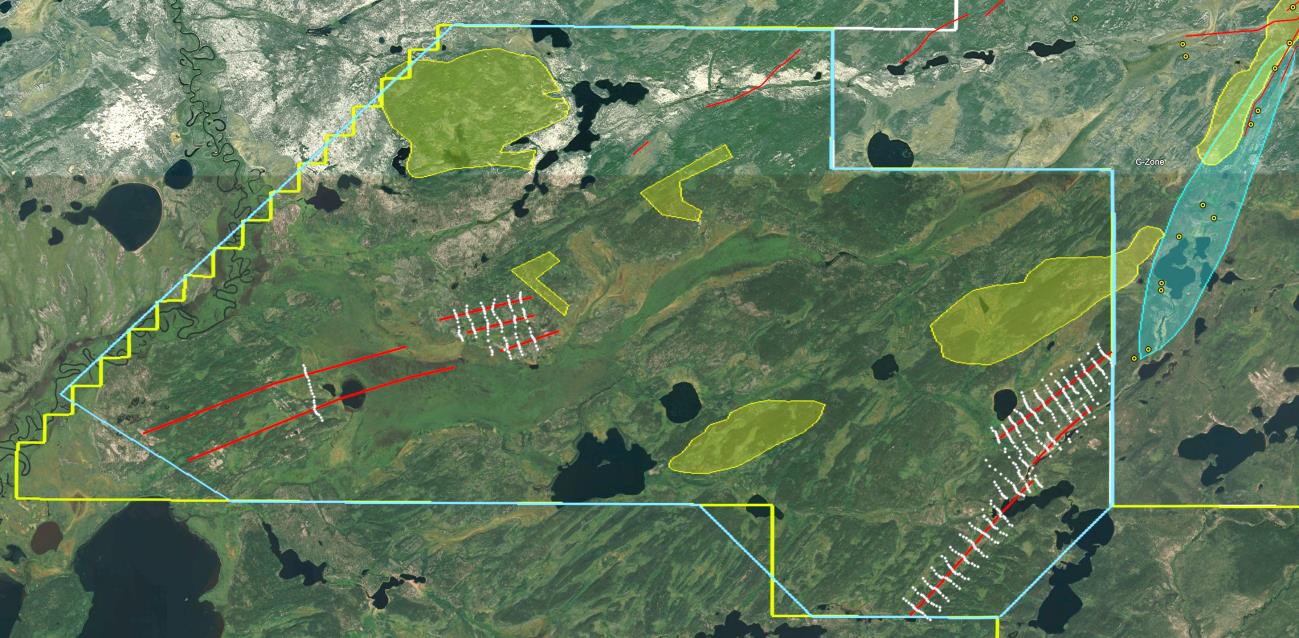
Figure 3: The CAT property is outlined in green and the western block of mag-EM surveying is outlined in blue. The light blue area at upper right is the conductive corridor currently being explored by Azincourt with its drill holes shown as yellow dots. Yellow-filled polygons outlined by white are areas of elevated radioactivity from historical surveys. Heavy red lines shown the location of EM conductors discovered by CAT. White dots on profiles across the conductors show the location of CAT's biogeochemical samples. The field of view is 18 km west to east.
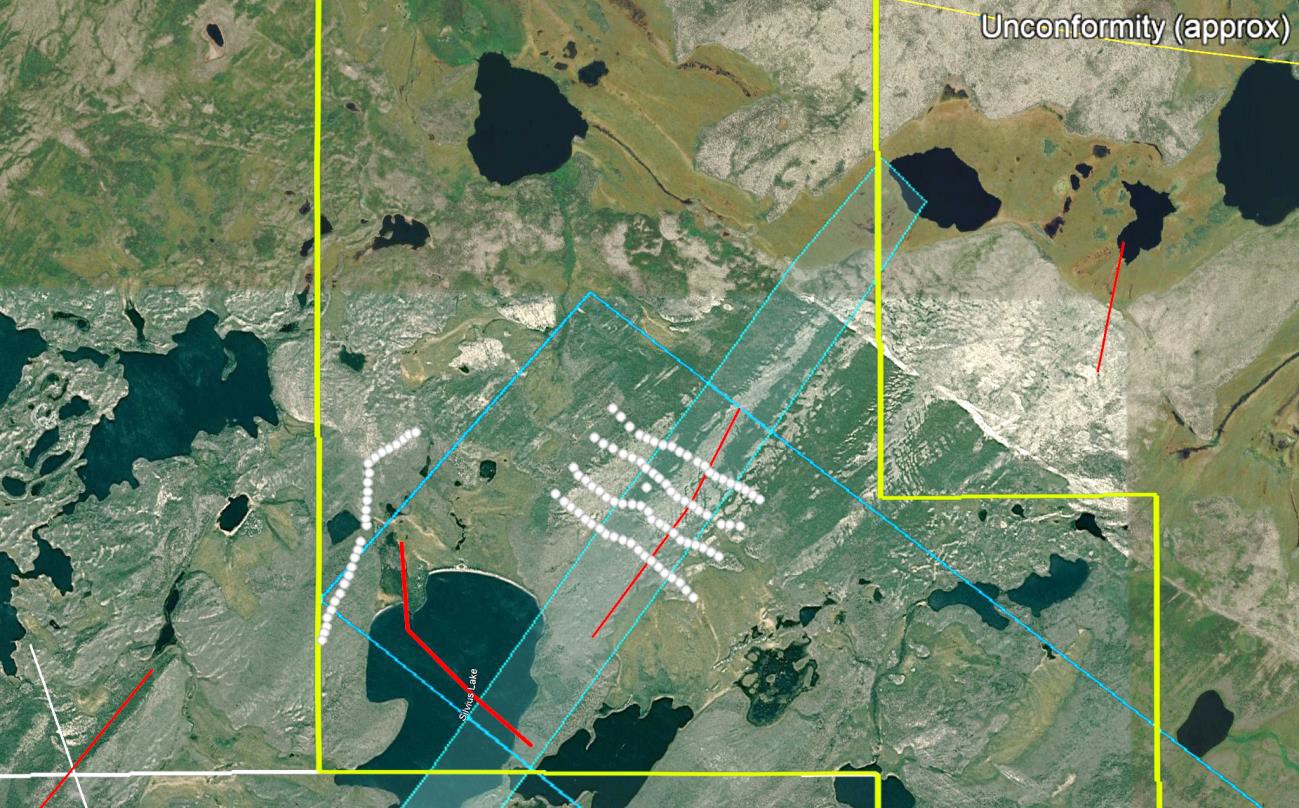
Figure 4: The CAT property is outlined in green. The eastern block surveyed by EM-mag is partially outlined in blue. Thin red lines show historical EM conductors generated by various means. The pale blue NNE-trending band indicates the location of frost heaved graphitic metasedimentary and pegmatitic boulders. The heavy red line at upper left crossing Silvius Lake is an EM conductor detected during the CAT survey. CAT's biogeochemical samples are shown as white dots. The field of view is approx. 7 km. west to east.
Follow-up exploration consisted of the geochemical sampling of black spruce (Picea mariana) twigs, and in the absence of black spruce, jackpine (Pinus banksiana) twigs were sampled as both have been shown to concentrate uranium to a similar degree over the Key Lake orebody1. As shown in Figures 3 and 4, CAT's samples were collected on parallel profiles with stations at 25 m intervals over the centreof a conductor, 50 m intervals on the shoulders of a conductor and at 100 m intervals in areas marginal to a conductor. Profiles were spaced at 150 to 200 m intervals along the conductor axis. A total of 38 profiles were sampled, ranging from 500 to 1,000 metres in length, and on which 718 samples were collected. Studies have demonstrated that black spruce and jackpine can be used together as effective biogeochemical collectors of uranium.

Figure 5: Black spruce (left) and jackpine (right) are the conifer species prevalent in the South Preston Project area.
Approximately one sample in every twenty was a duplicate taken for quality control purposes and to assess site variability. Sample locations were measured to within 2-3 metre accuracy by Garmin GPSMAP 64SX GPS instruments. At each site, the ambient levels of background and peak radiation were measured in total count, potassium, uranium and thorium windows using a Radiation Solutions RS-125 spectrometer. A suite of 81 representative rock samples including 3 quality control duplicates was also collected for the purpose of characterizing the bedrock in the survey area.
The effectiveness of this bio-geochemistry approach is well-established based on experience elsewhere in the Athabasca Basin. Using twig samples collected solely from black spruce in a test area, Dunn (1983) reported that differences in uranium concentrations are attributed to the amount of labile uranium that is accessible to the roots whether it is in the bedrock or dissolved in formation waters2. Dunn concluded that anomalies detected in the test area were the result of predominantly upward migrating, uranium-bearing formation waters sourced from uranium mineralization at the base of the Athabasca Group. Dunn expressed the view that "spruce twigs can provide a useful low-cost exploration tool for identifying uraniferous areas in boreal forests". A subsequent study over the McLean and Jeb orebodies at McLean Lake showed distinct anomalies closely associated with these deposits (Dunn, 1983)3. Uranium was concentrated in the black spruce twigs more than any part of any common species inthe test area. More recently, Dunn (2007) reviewed the results of 10,000 km2 of biogeochemical sampling in the Athabasca Basin noting that background values for uranium in black twig ash was less than 1 ppm4. It is clear from these studies that background levels of uranium can be variable and the magnitude of an anomaly above background is more important than the absolute strength of an anomaly as measured in parts per million.
During WGM's sampling program, needles were stripped from the twigs in recognition that the tree's up-take of metals such as uranium from the soil and underlying glacial deposits is concentrated in the twigs and not the needles. The samples were placed in numbered kraft sample bags and sent to the Saskatchewan Research Council's ("SRC") Geolab in Saskatoon where they were ashed, digested and instrumentally analysed for uranium, lead isotopes, major oxides and 48 trace elements. WGM's rock samples comprising granitic to granodioritic gneiss, pegmatitic gneiss, micaceous schist, amphibolite and graphitic schist were also shipped to the SRC Geolab for analysis for uranium and 43 elements by its conventional ICP-MS method.
1 Walker, N.C., 1979, Trace Elements in Vegetation and Soils Over the Key Lake Uranium-Nickel Orebody, Northern Saskatchewan, Canada, 9 pages.
2 Dunn, C.E., 1983, Uranium Biogeochemistry of the NEA/IAEA Athabasca Test Area, in Uranium Exploration in Athabasca Basin, Saskatchewan, Canada edited by Cameron, E.M., Geological Survey of Canada, Paper 82-11, pp. 127-132, 1983.
3 Dunn, C.E., 1983, Detailed Biogeochemical Studies for Athabasca Test Area, in Uranium Exploration in Athabasca Basin, Saskatchewan, Canada, edited by Cameron, E.M., Geological Survey of Canada, Paper 82-11, ;pp 259-272, 1983.
4 Dunn, C.E., 2007, New Perspectives on Biogeochemical Exploration, in Proceedings of Exploration 07: Fifth Decennial International Conference on Mineral Exploration edited by B. Milkereit, pp. 249-261
Analytical results for the bedrock samples were received in November, 2022. This data allowed WGM to classify the geological terrane on the CAT property as being similar to that hosting uranium deposits in other regions in the Athabasca Basin. The data will also help in establishing background concentrations against which future results may be classified as anomalous. Historical magnetometer data from a survey by the Western Athabasca Syndicate indicates the presence of a terrane boundary crossing the western part of the CAT property from northeast to southwest5.
Results from the biogeochemical sampling in three areas were very encouraging with uranium values ranging from trace levels to 187 ppm with a mean value of 7.9 ppm and a median of 3.27 ppm. Statistical analysis of the geochemical data indicates that twig samples in the western and eastern survey areas have significantly different background uranium levels, with mean ("m") values of 5.97 ppm and 18.13 ppm, respectively, and corresponding median values of 2.61 and
8.87 ppm. For this reason, the two populations were treated separately in respect to defining what was anomalous as indicated by the mean plus two standard deviations ("sd's"). The mean and median values are comparable to or higher than those reported by Walker in his paper on the bio-geochemistry of twig samples collected over the Key Lake orebodies. Similar mean values of 2 ppm uranium were reported by Uranerz Exploration and Mining Ltd.from black spruce and pine samples collected during 1978 in the Kelic Lake area, a short distance north of theCAT property 6. Uranerz anomalies in the range of 6 to 11 ppm uranium underscore the importance of CAT's results with anomalies in the range of 73 to 186 ppm uranium.
In plotting the results, WGM found that the mean value defined discrete areas within which anomalies occurred rather than producing the anticipated "spotted dog" effect of patchy highs and lows. Data was contoured at m+1sd and m+2sd. In the eastern survey area, anomalies were 4- 10 times the mean uranium value. In the western survey area, anomalies were 5-28 times the mean uranium value. Plots for the two western areas and the eastern area are given in Figures 6, 7 and 8.
In the western survey area, the geochemical anomalies are spatially associated with NE-trending conductors which underlie some of the major drainages in the survey area. Azincourt's drilling north of and adjacent to the CAT property indicate that these conductors are graphite-bearing shear zones. Elongated geochemical anomalies also appear to terminate against NW-trending topographic lineaments which are believed to represent orthogonal fault zones. Uranium values show no correlation with surface radioactivity (r=-0.02) which indicates that the uranium isunlikely to be sourced from transported radioactive boulders or glacial till. Taken together, these features strongly suggest a local source of uranium along sheared, graphite-bearing structures. While the grade, depth and specific location of such uranium is unknown, the results of the geochemical survey are highly encouraging.
5 Brown, J.A. and McKeough, M., 2014, Assessment Report: 2013 Geophysical, Geological and Geochemical Programs,Preston Project (Phase I-III), a report prepared for Skyharbour Resources Ltd.,
6 Rich, J, Williams, G. and Kuley, E., 1978, Uranerz Exploration and Mining Ltd. Assessment Report Inexco Mineral Disposition No. 1, CBS4432
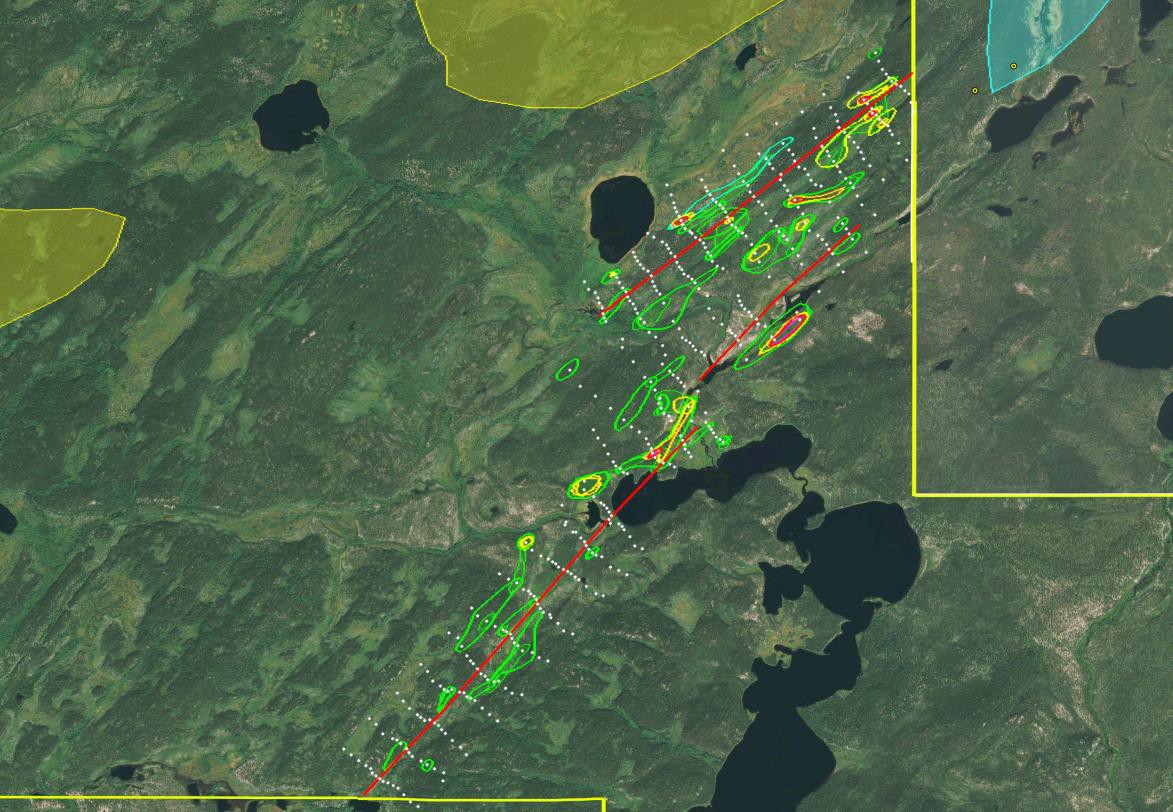
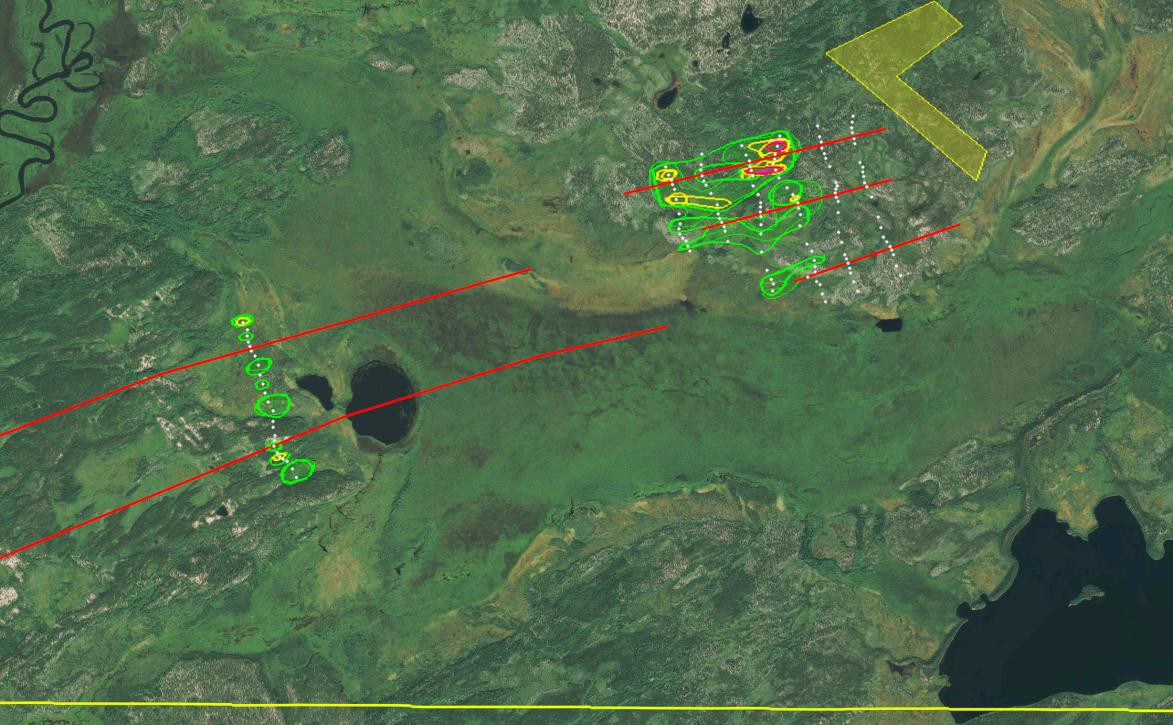
Figure 6: Uranium bio-geochemical anomalies in the western survey area. The green line surrounds values exceeding the m (5.97 ppm); orange surrounds values above m+1 s.d. (19.3 ppm) and red surrounds sites exceeding m+2s.d. (32.6 ppm). The highest uranium value was 118 ppm. Red NE-trending linear features are conductors discovered from CAT's July 2022 airborne survey. The CAT property boundary is indicated by yellow lines. Yellow shaded polygons are areas of elevated background radioactivity from historical data. The Azincourt ‘G-Zone' conductive corridor is indicated by the blue shaded area at upper right. North is up. The field of view is approx. 7 km east to west. The conductive features shown on the CAT property have a strike length of approximately 4,800 metres.
Figure 7: Uranium bio-geochemical anomalies in the western reconnaissance survey area. The green line surrounds values exceeding the m (5.97 ppm); orange surrounds values above m+1 s.d. (19.3 ppm) and red surrounds sites exceeding m+2s.d. (32.6 ppm). The highest uranium value was 81.6 ppm. Red ENE-trending linear features are conductors discovered from CAT's July 2022 airborne survey. The southern boundary of the CAT property is indicated by the yellow line. Yellow shaded polygons are areas of elevated background radioactivity from historical data. North is up. The field of viewis approx. 6 km east to west. The conductive features shown on the CAT property have a strike length of approximately 5,400 metres.
In the eastern survey area, strong uranium anomalies occur in an area having an elevated background uranium content in comparison to the western survey area. These anomalies are spatially associated with a weak historical conductor and a corridor containing graphitic rocks that did not produce a response in the most recent survey flown by CAT. The geochemical uranium anomalies are NE-trending and correspond to strong topographic lineaments which are believed to be related to bedrock structure.
The highest anomalies found to date on the CAT property are located in this eastern area despite it having a lower average background radioactivity. No correlation is seen between uranium geochemical values and spectrometer data with the exception of a weak positive correlation (r = 0.25) between uranium geochemistry and Th-channel spectrometer data, probably due to increased granite and pegmatite in the local bedrock.
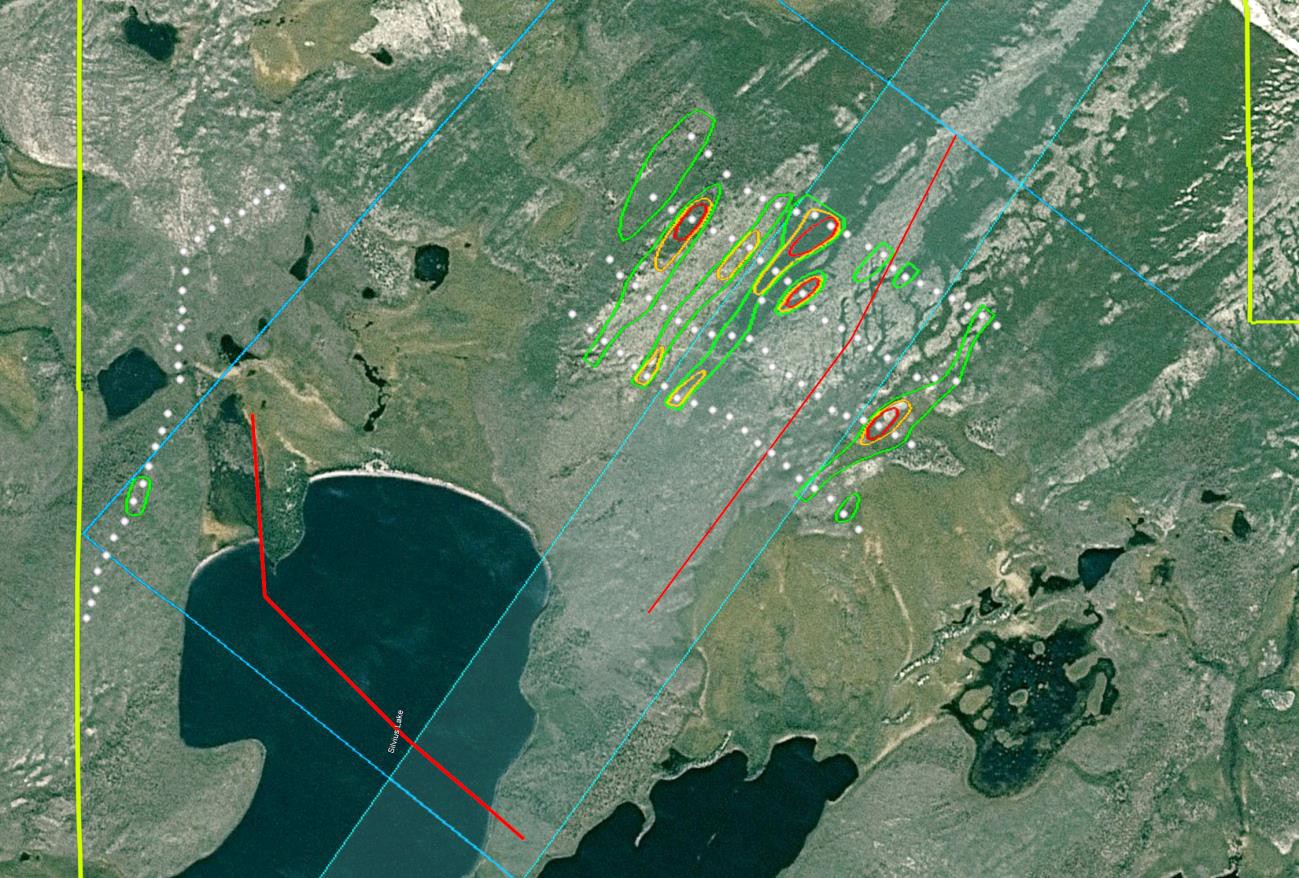
Figure 8: Uranium bio-geochemical anomalies in the eastern survey area. The green line surrounds values exceeding the m (18.1 ppm); orange surrounds values above m+1 s.d. (45.8 ppm) and red surrounds sites exceeding m+2s.d. (73.4 ppm). The highest uranium value was 186 ppm. A NW-trending conductor, partially under Silvius Lake, was detected from CAT's July 2022 airborne survey. Another historical conductor is shown as a red NE-trending line. The CAT property boundary is indicated by yellow lines. The pale blue corridor is a zone containing sheared and graphitic rocks inbedrock and in boulders. North is up. The field of view is approximately 3,500 m east to west. The NE-trending anomalies shown are 900 km in length but clearly extend NE and SW beyond the area sampled. The NE-trending lineaments in the terrain are though to reflect shearing in the underlying bedrock.
Further encouragement in all survey areas is provided from lead isotope ratios in the twig samples, specifically Pb207/Pb206 which are radiogenic products of uranium decay. According to Kyser et al (2015)7, values of less than 0.7 are considered to be indicative of underlying uranium mineralization at Cigar Lake and in the Athabasca Basin in general. In the western and eastern survey areas, samples with ratios of less than 0.7 accounted for
7 Kyser, K., Lahusen, L., Drever, G., Dunn, C., Leduc, E and Chipley, D., 2015, Using Pb Isotopes in Surface Media to Distinguish Anthropogenic Sources from Undercover Uranium Sources in Geoscience, Volume 347, pp. 215-226
Taken together, WGM believes that the results of the airborne EM survey and biogeochemical data provide strong evidence of uranium-bearing fluids moving along NE-trending conductive corridors and being concentrated in spruce and jackpine twigs via their root systems. The magnitude of the uranium anomalies significantly exceeds background levels as reported by Dunn (2007), and approaches the levels detected over major uranium deposits in the Athabasca Basin such as Key Lake. While the source of the uranium on the CAT property may not be directly below the anomalies, WGM believes the anomalies are well defined and should indicate a local source. If the source was from glacially transported till, one would expect broader and lower amplitude anomalies. The geochemical uranium anomalies are sufficiently high and spatially constrained to justify additional exploration.
CAT's South Preston Uranium Project comprises 29,395 hectares, and shares ~50km of contiguous claim border with Azincourt Energy Corp. which reported uranium enrichment within previously identified alteration zones. Azincourt recently reported the results of their 2022 Winter drill program and CAT is particularly encouraged by theresults of the recent drilling that occurred in Azincourt's G-Zone, which is quite close to the border of CAT's claimblock.
About CAT Strategic Metals Corporation (CAT)
CAT Strategic Metals' corporate strategy, as reflected in its overall Mission Statement, is to source, identify,acquire and advance property interests located in mineral districts proven to have world-class potential, primarily for gold and copper. In addition to the priority South Preston Uranium Project, CAT is focused on advancing the Burntland Project located northeast of St. Quentin in the Restigouche County, New Brunswick, Canada, directed at the exploration and development of several Skarn-hosted copper-silver, gold targets and the Gold Jackpot strategic metals property located NE of Elko, Nevada, in the Pequop gold-copper trend with multiple targets for gold-silver, copper, and tellurium. CAT's shares trade on the Canadian Securities Exchange (CSE) under the trading symbol "CAT", and on the Frankfurt Stock Exchange under the symbol "8CH".
ON BEHALF OF THE BOARD
Robert Rosner
Chairman, President & CEO
Further information regarding the Company can be found on SEDAR at www.SEDAR.com, by visiting the Company's website www.catstrategic.com or by contacting the Company directly at (604) 674-3145.
This news release has been reviewed for accuracy by Watts, Griffis and McOuat Ltd. ("WGM") of Toronto, Ontario, Canada. This release may contain forward-looking statements. Forward- looking statements address future events and conditions and therefore involve inherent risks and uncertainties. Actual results may differ materially from those currently anticipated in such statements. Particular risks applicable to this press release include risks associated with planned production, including the ability of the company to achieve its targeted exploration outline due to regulatory, technical or economic factors. In addition, there are risks associated with estimates of resources, and there is no guarantee that a resource will be found or have demonstrated economic viability as necessary to be classified as a reserve. There is no guarantee that additional exploration work will result in significant increases to resource estimates
Neither Canadian Securities Exchange nor its Regulation Services Provider (as that term is defined in policies of the Canadian Securities Exchange) accepts responsibility for the adequacy or accuracy of this release.
We seek safe harbour.
SOURCE: CAT Strategic Metals Corporation
View source version on accesswire.com:
https://www.accesswire.com/738819/CAT-Strategic-Completes-Initial-Ground-Follow-Up-Exploration-Over-Geophysical-Anomalies-on-South-Preston-Uranium-Project







